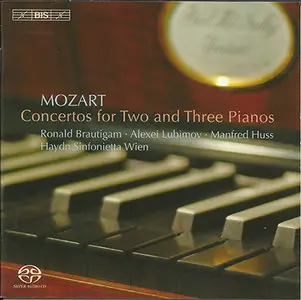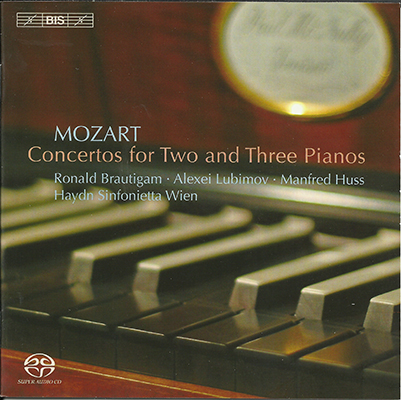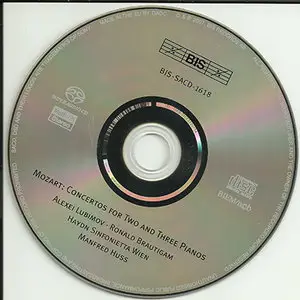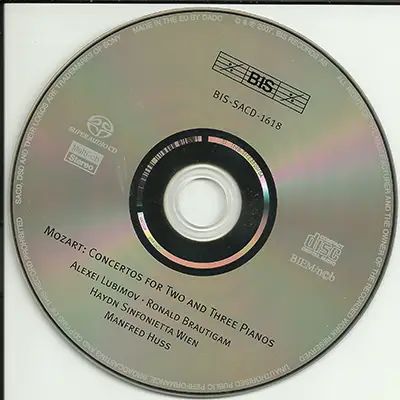Wolfgang Amadeus Mozart - Concertos for 2 & 3 Pianos
Haydn Sinfonietta Wien / Ronald Brautigam, Alexei Lubimov & Manfred Huss
SACD ISO (2.0/MCH): 3,13 GB | 24B/88,2kHz Stereo FLAC: 1,04 GB | Full Artwork
Label/Cat#: BIS # BIS-SACD-1618 | Country/Year: Sweden 2007 | 5% Recovery Info
Genre: Classical | Style: Viennese School
MD5 [X] CUE [ ] LOG [X] INFO TEXT [X] ARTWORK [X]
my rip [ ] not my rip [X]
16908366[0x102004e]: SACD-Ripper Version 0.36
16908366[0x102004e]: config: 00 00 00 0c 00 00 00 00 ff 41 00 04 00 00 00 00
16908366[0x102004e]: config: 00 00 00 00 00 00 00 00 00 00 00 00 00 00 00 00
16908366[0x102004e]: config: 00 00 00 00 00 00 00 00 00 00 00 00 00 00 00 00
16908366[0x102004e]: config: 00 00 00 00 00 00 00 00 00 00 00 00 00 00 00 00
16908366[0x102004e]: device_info: 75 6e 6e 61 6d 65 5c 10 80 00 00 00 00 53 a0 00
16908366[0x102004e]: device_info: 80 00 00 00 10 12 9e 70 80 00 00 00 00 5e a4 00
16908366[0x102004e]: device_info: 00 00 00 00 00 00 00 00 00 00 00 00 7f ff ff ff
16908366[0x102004e]: device_info: 00 00 08 00 00 00 00 01 00 01 01 00 00 00 00 01
16908366[0x102004e]: disc inserted..
16908366[0x102004e]: config: 00 00 00 0c 00 00 00 10 ff 41 01 04 00 00 00 00
16908366[0x102004e]: config: 00 00 00 00 00 00 00 00 00 00 00 00 00 00 00 00
16908366[0x102004e]: config: 00 00 00 00 00 00 00 00 00 00 00 00 00 00 00 00
16908366[0x102004e]: config: 00 00 00 00 00 00 00 00 00 00 00 00 00 00 00 00
16908366[0x102004e]: device_info: 75 6e 6e 61 6d 65 5c 10 80 00 00 00 00 53 a0 00
16908366[0x102004e]: device_info: 80 00 00 00 10 12 9e 70 80 00 00 00 00 5e a4 00
16908366[0x102004e]: device_info: 00 00 00 00 00 00 00 00 00 00 00 00 00 19 19 90
16908366[0x102004e]: device_info: 00 00 08 00 00 00 00 01 00 01 01 00 00 00 00 01
16908366[0x102004e]: Album Title: Mozart - Piano Concertos
16908366[0x102004e]: Album Artist: Lubimov, Brautigam, Huss - Haydn Sinf. Wien
16908366[0x102004e]: Disc Version: 01.20
16908366[0x102004e]: config: 00 00 00 0c 00 00 00 10 ff 41 01 04 00 00 00 00
16908366[0x102004e]: config: 00 00 00 00 00 00 00 00 00 00 00 00 00 00 00 00
16908366[0x102004e]: config: 00 00 00 00 00 00 00 00 00 00 00 00 00 00 00 00
16908366[0x102004e]: config: 00 00 00 00 00 00 00 00 00 00 00 00 00 00 00 00
16908366[0x102004e]: device_info: 75 6e 6e 61 6d 65 5c 10 80 00 00 00 00 53 a0 00
16908366[0x102004e]: device_info: 80 00 00 00 10 12 9e 70 80 00 00 00 00 5e a4 00
16908366[0x102004e]: device_info: 00 00 00 00 00 00 00 00 00 00 00 00 00 19 19 90
16908366[0x102004e]: device_info: 00 00 08 00 00 00 00 01 00 01 01 00 00 00 00 01
16908366[0x102004e]: succeeded. raw_spu number is 0
16908366[0x102004e]: succeeded. entry d0
16908366[0x102004e]: Establishing the interrupt tag on the interrupt PPU thread.
16908366[0x102004e]: ioctl_report_key1[45023901] 0
16908366[0x102004e]: sac_exec_generate_key 0 c9 0
16908366[0x102004e]: ioctl_send_key[2] c9 0
16908366[0x102004e]: ioctl_report_key[2] c8 0
16908366[0x102004e]: sac_exec_validate_key_1[0]
16908366[0x102004e]: sac_exec_generate_key_2[ae] 0
16908366[0x102004e]: ioctl_send_key[3] ae 0
16908366[0x102004e]: ioctl_report_key[3] b0 0
16908366[0x102004e]: sac_exec_validate_key_2[0]
16908366[0x102004e]: ioctl_report_key[4] 30 0
16908366[0x102004e]: sac_exec_validate_key_3[0]
16908366[0x102004e]: ioctl_report_finish [0xff] 0
16908366[0x102004e]: Queuing raw: /dev_usb002/Lubimov, Brautigam, Huss - Haydn Sinf. Wien - Mozart - Piano Concertos.iso, start_lsn: 0, length_lsn: 1644944
16908366[0x102004e]: config: 00 00 00 0c 00 00 00 00 ff 41 00 04 00 00 00 00
16908366[0x102004e]: config: 00 00 00 00 00 00 00 00 00 00 00 00 00 00 00 00
16908366[0x102004e]: config: 00 00 00 00 00 00 00 00 00 00 00 00 00 00 00 00
16908366[0x102004e]: config: 00 00 00 00 00 00 00 00 00 00 00 00 00 00 00 00
16908366[0x102004e]: device_info: 75 6e 6e 61 6d 65 5c 10 80 00 00 00 00 53 a0 00
16908366[0x102004e]: device_info: 80 00 00 00 10 12 9e 70 80 00 00 00 00 5e a4 00
16908366[0x102004e]: device_info: 00 00 00 00 00 00 00 00 00 00 00 00 7f ff ff ff
16908366[0x102004e]: device_info: 00 00 08 00 00 00 00 01 00 01 01 00 00 00 00 01
16908366[0x102004e]: disc inserted..
16908366[0x102004e]: config: 00 00 00 0c 00 00 00 10 ff 41 01 04 00 00 00 00
16908366[0x102004e]: config: 00 00 00 00 00 00 00 00 00 00 00 00 00 00 00 00
16908366[0x102004e]: config: 00 00 00 00 00 00 00 00 00 00 00 00 00 00 00 00
16908366[0x102004e]: config: 00 00 00 00 00 00 00 00 00 00 00 00 00 00 00 00
16908366[0x102004e]: device_info: 75 6e 6e 61 6d 65 5c 10 80 00 00 00 00 53 a0 00
16908366[0x102004e]: device_info: 80 00 00 00 10 12 9e 70 80 00 00 00 00 5e a4 00
16908366[0x102004e]: device_info: 00 00 00 00 00 00 00 00 00 00 00 00 00 19 19 90
16908366[0x102004e]: device_info: 00 00 08 00 00 00 00 01 00 01 01 00 00 00 00 01
16908366[0x102004e]: Album Title: Mozart - Piano Concertos
16908366[0x102004e]: Album Artist: Lubimov, Brautigam, Huss - Haydn Sinf. Wien
16908366[0x102004e]: Disc Version: 01.20
16908366[0x102004e]: config: 00 00 00 0c 00 00 00 10 ff 41 01 04 00 00 00 00
16908366[0x102004e]: config: 00 00 00 00 00 00 00 00 00 00 00 00 00 00 00 00
16908366[0x102004e]: config: 00 00 00 00 00 00 00 00 00 00 00 00 00 00 00 00
16908366[0x102004e]: config: 00 00 00 00 00 00 00 00 00 00 00 00 00 00 00 00
16908366[0x102004e]: device_info: 75 6e 6e 61 6d 65 5c 10 80 00 00 00 00 53 a0 00
16908366[0x102004e]: device_info: 80 00 00 00 10 12 9e 70 80 00 00 00 00 5e a4 00
16908366[0x102004e]: device_info: 00 00 00 00 00 00 00 00 00 00 00 00 00 19 19 90
16908366[0x102004e]: device_info: 00 00 08 00 00 00 00 01 00 01 01 00 00 00 00 01
16908366[0x102004e]: succeeded. raw_spu number is 0
16908366[0x102004e]: succeeded. entry d0
16908366[0x102004e]: Establishing the interrupt tag on the interrupt PPU thread.
16908366[0x102004e]: ioctl_report_key1[45023901] 0
16908366[0x102004e]: sac_exec_generate_key 0 c9 0
16908366[0x102004e]: ioctl_send_key[2] c9 0
16908366[0x102004e]: ioctl_report_key[2] c8 0
16908366[0x102004e]: sac_exec_validate_key_1[0]
16908366[0x102004e]: sac_exec_generate_key_2[ae] 0
16908366[0x102004e]: ioctl_send_key[3] ae 0
16908366[0x102004e]: ioctl_report_key[3] b0 0
16908366[0x102004e]: sac_exec_validate_key_2[0]
16908366[0x102004e]: ioctl_report_key[4] 30 0
16908366[0x102004e]: sac_exec_validate_key_3[0]
16908366[0x102004e]: ioctl_report_finish [0xff] 0
16908366[0x102004e]: Queuing raw: /dev_usb002/Lubimov, Brautigam, Huss - Haydn Sinf. Wien - Mozart - Piano Concertos.iso, start_lsn: 0, length_lsn: 1644944
Lubimov, Brautigam, Huss - Haydn Sinf. Wien - [2007] Mozart - Piano Concertos [2.0] (SACD[PS3] - 24bit88.2kHz)
======================================================================================
SACD[PS3]ISO to flac conversion using SACD_Conversion_script version 0.5
Track list
–––––
01 Concerto Kv 365 (1779): I. Allegro 09:58.59
02 II. Andante 06:33.43
03 III. Rondeau 07:03.11
04 Concerto Kv 242: I. Allegro 08:26.49
05 II. Adagio 06:58.96
06 III. Rondeau 05:45.73
07 Concerto Kv 365 (1782): I. Allegro 10:22.63
08 II. Andante 06:38.83
09 III. Rondeau 07:16.24
Technical Details
––––––––-
01) ISO image created using sacd-ripper for PS3
02) Edited Master Dff file extracted using SACD_Extract
03) Edited Master Dff file analysed using foobar + foo_input_sacd and DR Meter plugins to find peak track(s)
04) Dff files for loudest tracks extracted from the ISO using SACD_Extract and converted using Weiss Saracon 1.61-27 at 24bit/88.2kHz with -6.00dB gain
05) Non-clipping gain calculated using SoX
06) Final pass conversion using Weiss Saracon 1.61-27 at 24bit/88.2kHz with 6.00dB gain as calculated above
07) Final pass PCM file split into individual tracks (discarding first 41 samples) using track lengths calculated from cue file generated by SACD_Extract
08) Spikes at beginning of first/end of last tracks eliminated by deleting 24 samples and replacing with the adjacent 24 samples using SoX to give the correct track length
09) Finalised tracks converted to flac [level 8] and tagged using tag.exe
10) Dynamic Range measured using Foobar DR Meter plugin
foobar2000 1.1.11 / Dynamic Range Meter 1.1.1
log date: 2014-02-06 07:06:30
––––––––––––––––––––––––––––––––––––––––
Analyzed: Lubimov, Brautigam, Huss - Haydn Sinf. Wien / Mozart - Piano Concertos
––––––––––––––––––––––––––––––––––––––––
DR Peak RMS Duration Track
––––––––––––––––––––––––––––––––––––––––
DR13 -5.54 dB -24.86 dB 9:59 01-Concerto Kv 365 (1779): I. Allegro
DR14 -9.92 dB -30.07 dB 6:33 02-II. Andante
DR14 -2.57 dB -24.18 dB 7:03 03-III. Rondeau
DR16 -0.49 dB -22.46 dB 8:26 04-Concerto Kv 242: I. Allegro
DR14 -5.74 dB -25.76 dB 6:59 05-II. Adagio
DR14 -3.79 dB -25.27 dB 5:46 06-III. Rondeau
DR14 -1.59 dB -22.46 dB 10:23 07-Concerto Kv 365 (1782): I. Allegro
DR14 -11.17 dB -29.79 dB 6:39 08-II. Andante
DR15 -0.30 dB -23.06 dB 7:16 09-III. Rondeau
––––––––––––––––––––––––––––––––––––––––
Number of tracks: 9
Official DR value: DR14
Samplerate: 88200 Hz
Channels: 2
Bits per sample: 24
Bitrate: 2166 kbps
Codec: FLAC
================================================================================
======================================================================================
SACD[PS3]ISO to flac conversion using SACD_Conversion_script version 0.5
Track list
–––––
01 Concerto Kv 365 (1779): I. Allegro 09:58.59
02 II. Andante 06:33.43
03 III. Rondeau 07:03.11
04 Concerto Kv 242: I. Allegro 08:26.49
05 II. Adagio 06:58.96
06 III. Rondeau 05:45.73
07 Concerto Kv 365 (1782): I. Allegro 10:22.63
08 II. Andante 06:38.83
09 III. Rondeau 07:16.24
Technical Details
––––––––-
01) ISO image created using sacd-ripper for PS3
02) Edited Master Dff file extracted using SACD_Extract
03) Edited Master Dff file analysed using foobar + foo_input_sacd and DR Meter plugins to find peak track(s)
04) Dff files for loudest tracks extracted from the ISO using SACD_Extract and converted using Weiss Saracon 1.61-27 at 24bit/88.2kHz with -6.00dB gain
05) Non-clipping gain calculated using SoX
06) Final pass conversion using Weiss Saracon 1.61-27 at 24bit/88.2kHz with 6.00dB gain as calculated above
07) Final pass PCM file split into individual tracks (discarding first 41 samples) using track lengths calculated from cue file generated by SACD_Extract
08) Spikes at beginning of first/end of last tracks eliminated by deleting 24 samples and replacing with the adjacent 24 samples using SoX to give the correct track length
09) Finalised tracks converted to flac [level 8] and tagged using tag.exe
10) Dynamic Range measured using Foobar DR Meter plugin
foobar2000 1.1.11 / Dynamic Range Meter 1.1.1
log date: 2014-02-06 07:06:30
––––––––––––––––––––––––––––––––––––––––
Analyzed: Lubimov, Brautigam, Huss - Haydn Sinf. Wien / Mozart - Piano Concertos
––––––––––––––––––––––––––––––––––––––––
DR Peak RMS Duration Track
––––––––––––––––––––––––––––––––––––––––
DR13 -5.54 dB -24.86 dB 9:59 01-Concerto Kv 365 (1779): I. Allegro
DR14 -9.92 dB -30.07 dB 6:33 02-II. Andante
DR14 -2.57 dB -24.18 dB 7:03 03-III. Rondeau
DR16 -0.49 dB -22.46 dB 8:26 04-Concerto Kv 242: I. Allegro
DR14 -5.74 dB -25.76 dB 6:59 05-II. Adagio
DR14 -3.79 dB -25.27 dB 5:46 06-III. Rondeau
DR14 -1.59 dB -22.46 dB 10:23 07-Concerto Kv 365 (1782): I. Allegro
DR14 -11.17 dB -29.79 dB 6:39 08-II. Andante
DR15 -0.30 dB -23.06 dB 7:16 09-III. Rondeau
––––––––––––––––––––––––––––––––––––––––
Number of tracks: 9
Official DR value: DR14
Samplerate: 88200 Hz
Channels: 2
Bits per sample: 24
Bitrate: 2166 kbps
Codec: FLAC
================================================================================
foobar2000 1.1.14a / Dynamic Range Meter 1.1.1
log date: 2015-06-28 13:48:17
––––––––––––––––––––––––––––––––––––––––
Analyzed: Lubimov, Brautigam, Huss - Haydn Sinf. Wien / Mozart - Piano Concertos
––––––––––––––––––––––––––––––––––––––––
DR Peak RMS Duration Track
––––––––––––––––––––––––––––––––––––––––
DR13 -5.54 dB -24.86 dB 9:59 01-Concerto Kv 365 (1779): I. Allegro
DR14 -9.92 dB -30.07 dB 6:33 02-II. Andante
DR14 -2.57 dB -24.18 dB 7:03 03-III. Rondeau
DR16 -0.49 dB -22.46 dB 8:26 04-Concerto Kv 242: I. Allegro
DR14 -5.74 dB -25.76 dB 6:59 05-II. Adagio
DR14 -3.79 dB -25.27 dB 5:46 06-III. Rondeau
DR14 -1.59 dB -22.46 dB 10:23 07-Concerto Kv 365 (1782): I. Allegro
DR14 -11.17 dB -29.79 dB 6:39 08-II. Andante
DR15 -0.30 dB -23.06 dB 7:16 09-III. Rondeau
––––––––––––––––––––––––––––––––––––––––
Number of tracks: 9
Official DR value: DR14
Samplerate: 88200 Hz
Channels: 2
Bits per sample: 24
Bitrate: 2166 kbps
Codec: FLAC
================================================================================
log date: 2015-06-28 13:48:17
––––––––––––––––––––––––––––––––––––––––
Analyzed: Lubimov, Brautigam, Huss - Haydn Sinf. Wien / Mozart - Piano Concertos
––––––––––––––––––––––––––––––––––––––––
DR Peak RMS Duration Track
––––––––––––––––––––––––––––––––––––––––
DR13 -5.54 dB -24.86 dB 9:59 01-Concerto Kv 365 (1779): I. Allegro
DR14 -9.92 dB -30.07 dB 6:33 02-II. Andante
DR14 -2.57 dB -24.18 dB 7:03 03-III. Rondeau
DR16 -0.49 dB -22.46 dB 8:26 04-Concerto Kv 242: I. Allegro
DR14 -5.74 dB -25.76 dB 6:59 05-II. Adagio
DR14 -3.79 dB -25.27 dB 5:46 06-III. Rondeau
DR14 -1.59 dB -22.46 dB 10:23 07-Concerto Kv 365 (1782): I. Allegro
DR14 -11.17 dB -29.79 dB 6:39 08-II. Andante
DR15 -0.30 dB -23.06 dB 7:16 09-III. Rondeau
––––––––––––––––––––––––––––––––––––––––
Number of tracks: 9
Official DR value: DR14
Samplerate: 88200 Hz
Channels: 2
Bits per sample: 24
Bitrate: 2166 kbps
Codec: FLAC
================================================================================
SACD Info:
Wolfgang Amadeuts Mozart - Concertos for 2 & 3 Pianos
Haydn Sinfonietta Wien / Ronald Brautigam, Alexei Lubimov & Manfred Huss
Label: BIS
Catalog#: BIS-SACD-1618
Format: Hybrid-SACD, Album, Stereo, Multichannel
Country: Sweden
Released: 2007
Genre: Classical
Style: Viennese School, Piano
Tracklist:
1. Concerto for 2 pianos & orchestra in E flat major ('Concerto No. 10'), K. 365 (K. 316a): 1. Allegro
2. Concerto for 2 pianos & orchestra in E flat major ('Concerto No. 10'), K. 365 (K. 316a): 2. Andante
3. Concerto for 2 pianos & orchestra in E flat major ('Concerto No. 10'), K. 365 (K. 316a): 3. Rondeau. Allegro
4. Concerto for 3 (or 2) pianos & orchestra in F major ('Lodron,' 'Concerto No. 7'), K. 242: 1. Allegro
5. Concerto for 3 (or 2) pianos & orchestra in F major ('Lodron,' 'Concerto No. 7'), K. 242: 2. Adagio
6. Concerto for 3 (or 2) pianos & orchestra in F major ('Lodron,' 'Concerto No. 7'), K. 242: 3. Rondeau. Tempo di Menuetto
7. Concerto for 2 pianos & orchestra in E flat major ('Concerto No. 10'), K. 365 (K. 316a): 1. Allegro
8. Concerto for 2 pianos & orchestra in E flat major ('Concerto No. 10'), K. 365 (K. 316a): 2. Andante
9. Concerto for 2 pianos & orchestra in E flat major ('Concerto No. 10'), K. 365 (K. 316a): 3. Rondeau. Allegro
Credits:
Performer: Manfred Huss, Ronald Brautigam, Aleksei Lubimov
Orchestra: Haydn Sinfonietta
Conductor: Manfred Huss
This is a truly lovely recording, with original instruments, beautifully played, with devotion and care. It is also possibly the closest you will ever get to how it would have sounded, performed by the composer himself, had the technology been available to capture it when Mozart was alive.
The first piece, Concerto in E flat major for Two Pianos KV 365, also known as Piano Concerto No. 10, was the last of Mozart’s piano concertos written in Salzburg, before he left for Vienna. He composed it for his sister Nannerl and himself, and right from the start, it is obvious that she was also a gifted keyboard performer. In this recording, the piece is performed in its two versions: the original from 1779, with a small orchestra, and the other from 1782 with an extended orchestra, which deservedly gives it a certain grandeur. The work is built in three movements and is challenging for both soloists. The parts for the two pianos are equally assigned and Mozart was careful to divide up the most striking and virtuosic passages evenly between the two solo players. The first movement, Allegro, opens with a long, ambitious orchestral introduction. Both pianos finally enter together, briefly alternating introductory phrases, as if exchanging ideas with each other, to then join again in the first theme. A second theme appears afterwards, more dramatic, giving briefly the impression that something bad might be about to happen, but this never takes place. The orchestra puts an end to it by repeating the opening and leading the movement to its finish, a beautifully fluid cadenza and coda. This is brilliantly delivered by Alexei Lubimov, who plays piano 1, and Ronald Brautigam, who plays piano 2. It is all done in a suitably witty, playful and charming manner and one can imagine two siblings performing and enjoying themselves together. This fact was natural for both Wolfgang and Nannerl, who were used to performing together from a very young age but who also understood and liked each other on a personal level. The musical rapport between Lubimov and Brautigam is already present in this first movement and does justice to the Mozart siblings.
In the second movement, Andante, slow and refined, they continue the playful dialogue as if engaging in a healthy, joyful competition. After the introductory theme, a minuet, by the orchestra, the same theme appears in the pianos, divided into two solo passages to allow the soloists to demonstrate their skills individually. The two pianists soon seem to flow together again, as the movement progresses, nicely leading and accompanying each other, beautifully alternating with the orchestra though it suitably stays in the background allowing the two keyboard performers to shine. This movement finishes almost abruptly, to take us into the finale, Rondeau, Allegro, wonderfully scored by Mozart to the instruments of his day. It has such size and power that one cannot help but wonder what he would have achieved with modern day grand pianos. Again, Lubimov and Brautigam, excel and deliver the piece perfectly, with rhythmic drive and equal elegance both in the lyrical graceful passages and in the exuberant return to the main rondo theme. They left me enchanted, wishing that I could have been present to participate in such musical joy.
To my mind, the greatest achievement of the two soloists is undoubtedly the fact that very often one wonders if there are two pianos or only one, though some of the score would be physically impossible for one soloist. Without the actual view of the two pianists on stage, it is difficult to believe that, in some passages, we are listening to two distinct people. We have in Lubimov and Brautigam, two musicians of unquestionable virtuosity, who perform the piece on the fortepianos of Mozart’s time and, I believe, as the composer intended, telling musical stories playfully to each other while interfacing and alternating with the orchestra, who also use period instruments. The Haydn Sinfonietta Wien plays wonderfully throughout, suitably cushioning the two soloists, taking them along or gently conversing. Manfred Huss’s direction is expertly sensitive and delicate throughout, demonstrating his great understanding of the period instruments and of the capabilities, not only of the soloists, but also of his musicians. Clearly he feels comfortably at home with the orchestra he founded in 1984 and has led ever since.
The other piece, in this wonderful recording, is the Concerto in F major for Three Pianos KV 242, also known as Piano Concerto No. 7 or the Lodron Concerto. The name Lodron refers to the fact that this was a piece commissioned by the Countess of Lodron for herself and her two daughters. Mozart completed and presented it to her in 1776, aged only twenty. As he frequently did on such occasions, the composer geared each part to the performer who would play it, with the degree of difficulty adjusted to the differences in skill and experience. In this case, two of the solo parts are moderately difficult, while the third, for the younger of the two girls, is carefully written with fewer technical difficulties. The contribution of the third piano is much more modest and in fact the piece loses little when transferred for two soloists. A few years later, Mozart actually composed a different version for only two pianos, which he performed, for the last time, in 1780, in Salzburg, with his sister Nannerl. The fact that the solo parts do not require virtuoso performances, has sometimes caused the work to be dismissed as one of Mozart’s weaker pieces, however it cannot be rendered unimaginative. One should never forget that he composed it, not for himself but for three lady amateurs who were his students and who naturally wanted a piece that would give delight to themselves as performers as well as to their guests as listeners.
The first movement, Allegro, has an almost roaring opening by the orchestra and soon the combined presence of the three soloists produces rich, though not complex counterpoint, maintaining a charming, pleasant quality throughout, delicate and enchanting, almost feminine in style. These attributes are repeated in the third and final movement, Rondeau, Tempo di Minuetto, as the name indicates, like a minuet, which gives each soloist considerable attention, allowing them to shine as individuals though assigning to the orchestra the responsibility of building up to a dramatic finale. It is the second movement, Adagio, which contains expression equal to Mozart’s greatest works, defined by its lyrical, melodic passages. The two soloists from the Concerto in E flat major for Two Pianos, Lubimov and Brautigam, are here joined by Huss who conducts the orchestra from the keyboard, playing the third piano part. They deliver it with the same delightful, joyful enthusiasm which they had previously applied to the more virtuosic parts of the Concerto for Two Pianos. The result is totally charming, delicate, pleasantly poetic and entertaining, perfectly interpreting the composer’s intentions of making his three lady students shine in the presence of their guests. Again the Haydn Sinfonietta rises to the occasion, enhancing the performances of the three soloists, as well as carrying out the responsibility given them by the composer to deliver the more complex, dramatic parts, as the countess and her two daughters were moderately skilful performers.
The sound of the fortepianos and the orchestra is gloriously pure and clear throughout, giving the concertos a fresh, crystalline quality and purity of tone that I have seldom heard. The technical superiority of the SACD hybrid disc is very obvious, leaving one wondering why the record labels do not do more of these, particularly for classical compositions.
In short, this CD is a delight from begin to end. It will make you want to see and hear the two pieces performed live because only then can one fully enjoy the virtuosic playfulness and beauty of the musical interchange between the two pianos in the Concerto in E flat major; not to mention the pure divertimento of the Concerto in F major, which is a recreational, uplifting and entertaining.
Margarida Mota-Bull ~musicweb-international
With kind permission by ManWhoCan. Thanks a lot!







